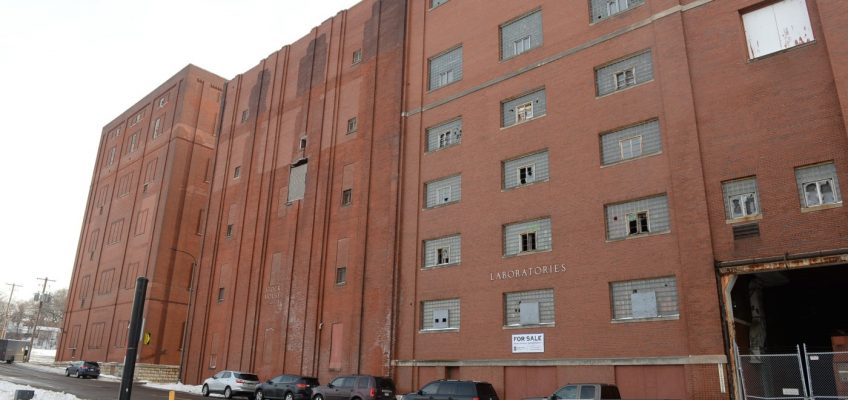Citing concerns about “spot zoning,” the St. Paul Planning Commission has dealt a setback to a proposal to add more than 200 units of affordable, multi-family and artist housing at the Hamm’s Brewery campus in Dayton’s Bluff.
The city has worked closely with developer JB Vang on efforts to install affordable apartments between Payne Avenue and Seventh Street, on five city-owned acres of the long-underutilized brewery.
The effort have been opposed by brewpub owner Rob Clapp, who operates St. Paul Brewing and owns several other buildings on the same campus.
Clapp has said the new housing should be reconfigured as it would take up much of a shared parking lot he uses for his existing and nascent businesses. They include an industrial crafting shop, a distillery, a planned pop-up bar and a future cocktail tasting room.
Vote on zoning
On Friday, the Planning Commission debated rezoning five parcels of land, most of it currently zoned I2, or general industrial zoning, to H2, T3 and RM 2, which are residential, traditional neighborhood and medium-density family zoning, respectively. After an hour-long debate, they approved rezoning three of the parcels, but voted 9-2 against removing industrial zoning from existing brewery buildings at 680 and 694 Minnehaha Ave. East, as well as the shared parking lot.
Clapp, in his letters to the city, pointed out the proposed new T3 zone would be isolated from any other nearby T3-zoned parcel, creating an island of residential zoning with smaller islands of industrial zoning within it, and common driveways connecting them.
“In effect, the proposal will authorize a new kind of hybrid zoning where uses that the city has previously concluded are incompatible could exist within the same site,” said his attorney, Dan Hall, in a separate letter.
Hall pointed to the hypothetical possibility of a future crematorium, municipal incinerator, gun shop, shooting gallery, pawn shop, auto repair, or warehousing and storage that could “overlap with residential housing targeted specifically to families with young children.” Instead of pursuing rezoning, Clapp said a developer might seek a variance for adding an apartment building within an industrial zone, “so there are certainly other ways to advance,” he wrote.
A protracted debate
Minnesota courts have long frowned on “spot zoning,” or rezoning small, isolated plots of land within a larger area with incompatible zoning.
“This is pretty clearly spot zoning,” said Commissioner Richard Holst leading into the vote, noting the city should have done more to find common ground between what he deemed as two respected developers, or simply rezoned half the campus T3. “I’m looking at a map with three spots on them. We made the spots by going around them. … If this doesn’t look like spot zoning, I don’t know what does.”
The Planning Commission debated those arguments at length, noting one of the land parcels was already split-zoned between residential and industrial. Rezoning for that particular parcel was later approved.
“I think it’s complicated because we’re talking about so many individual parcels,” said Planning Commission Chair Kristine Grill. “I think it can look challenging on the map, but be practical in reality. That’s where I came down on voting in favor.”
Commissioner Nate Hood noted the commission’s zoning committee previously found the series of rezonings would not constitute spot zoning, given the mix of businesses and residences nearby. After debating both sides, he said he ultimately disagreed.
“You have two or three islands (of industrial use remaining) within the larger parcel,” Hood said, acknowledging that future development in “that long-range hypothetical could cause incompatible uses.”
Chris Hong, a city planner, said two district councils had recommended approving the rezoning, which supports the redevelopment vision laid out in neighborhood plans and the city’s overarching Comprehensive Plan. The city attorney’s office had found that the rezoning did not constitute spot zoning.
“The Comprehensive Plan has designated the site as an ‘Opportunity Site,’ which calls for higher density, mixed-use developments or employment centers,” said Hong, addressing the Planning Commission on Friday morning. “The rezoning would facilitate the development of these parcels, which have been vacant for nearly 30 years.”
The Planning Commission decision could yet be appealed to the St. Paul City Council.
Related Articles
CommonBond Communities to outsource, layoff 117 from St. Paul headquarters
St. Paul: At Highland Bridge, Weidner Homes, Ryan Cos. win concessions
St. Paul WestRock plant owners look to sell ‘as soon as possible’
St. Paul City Council ends rent control for housing built after 2004
St. Paul Port Authority, developers bullish on St. Paul’s WestRock site


Leave a Reply